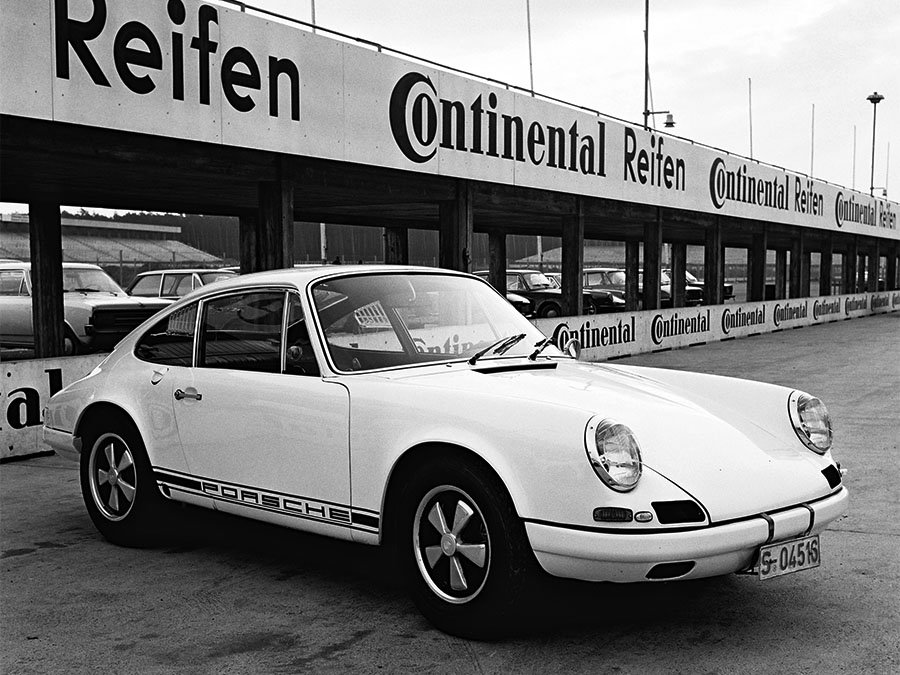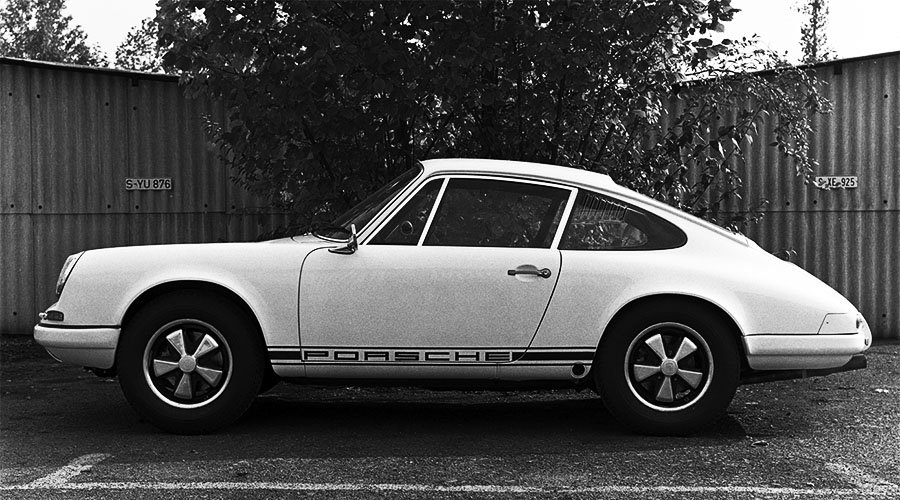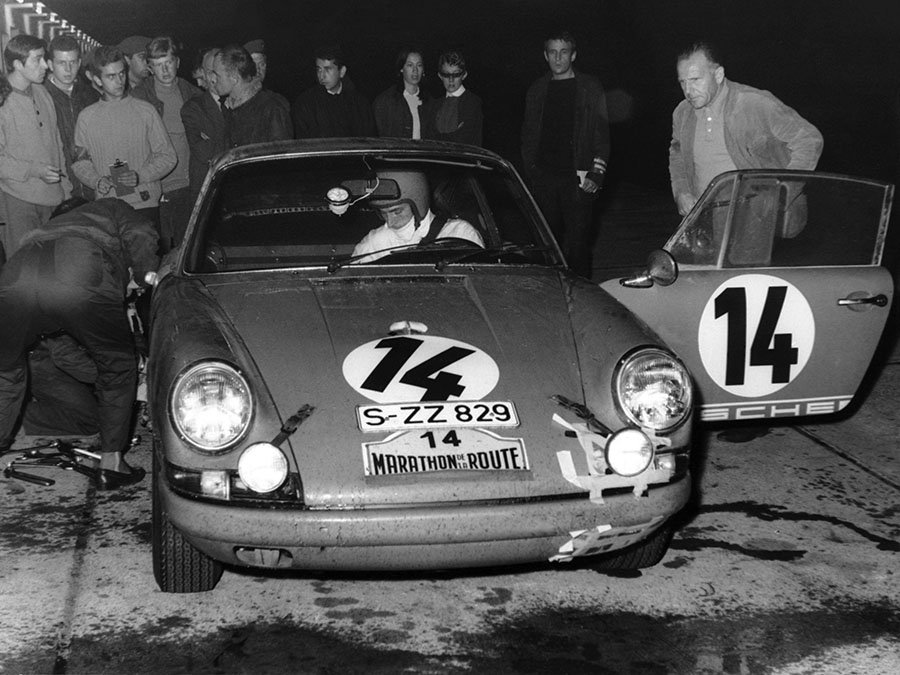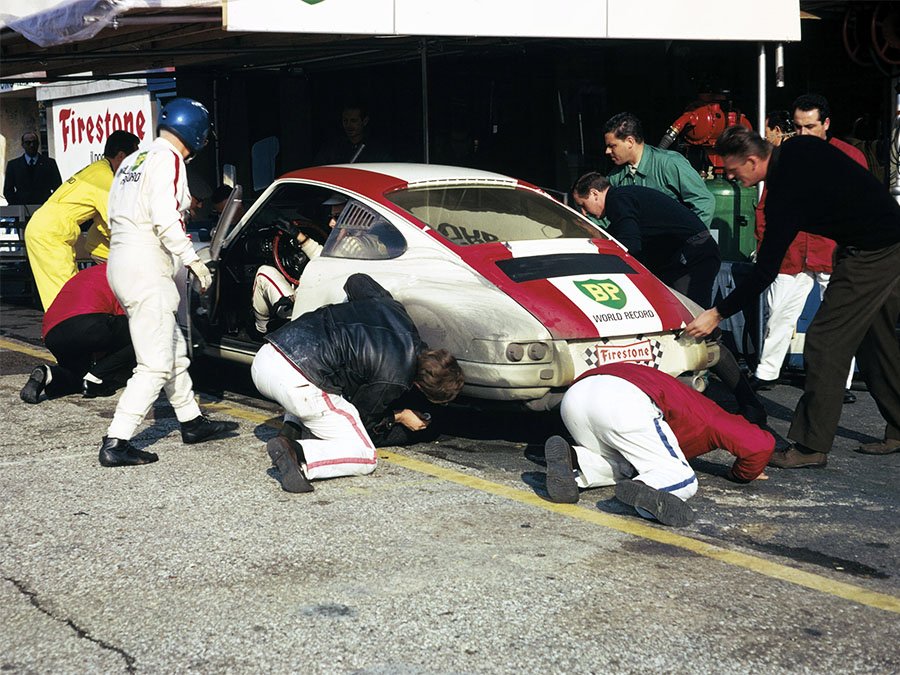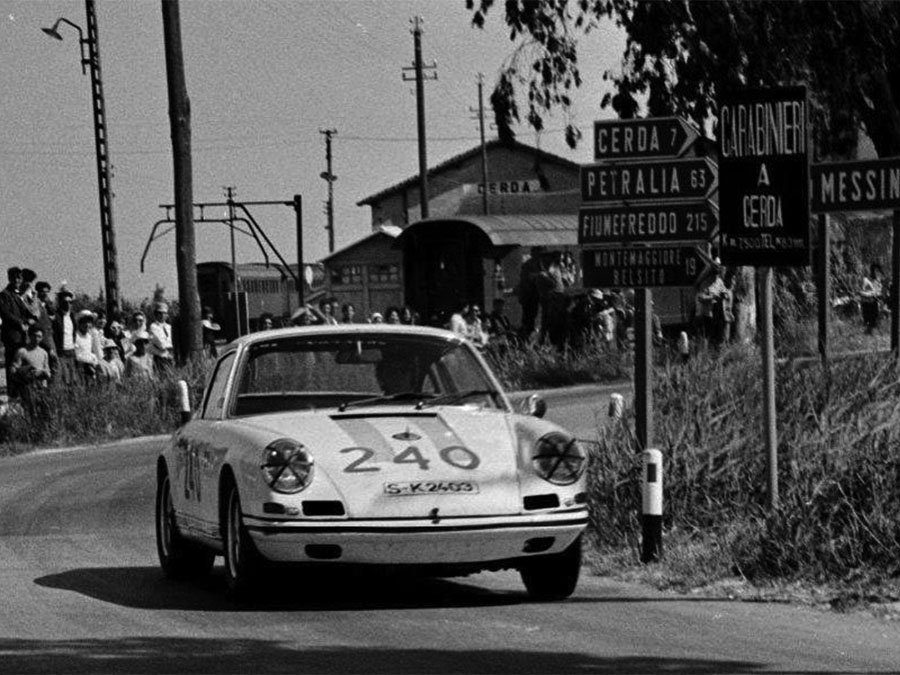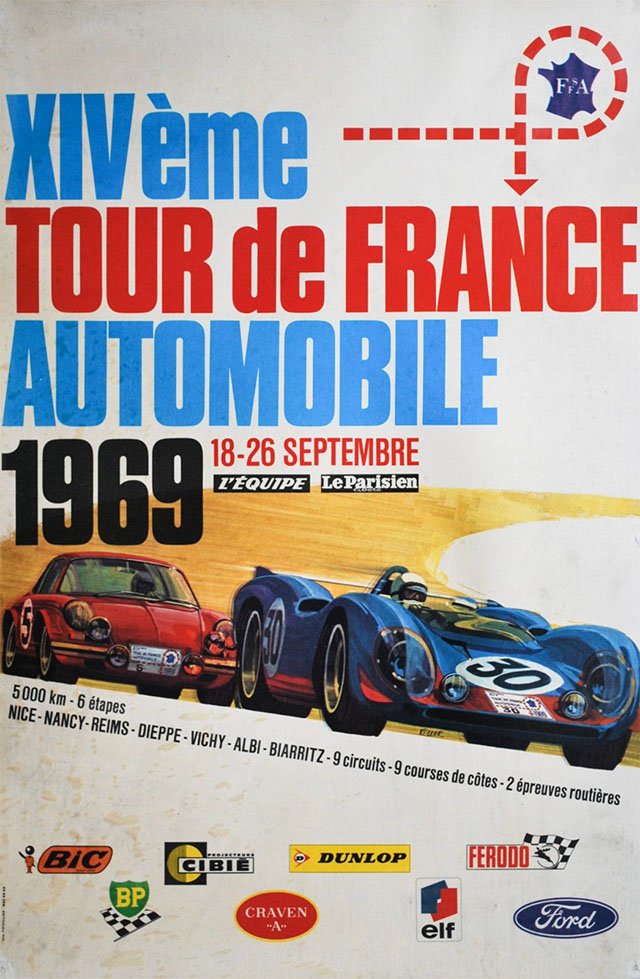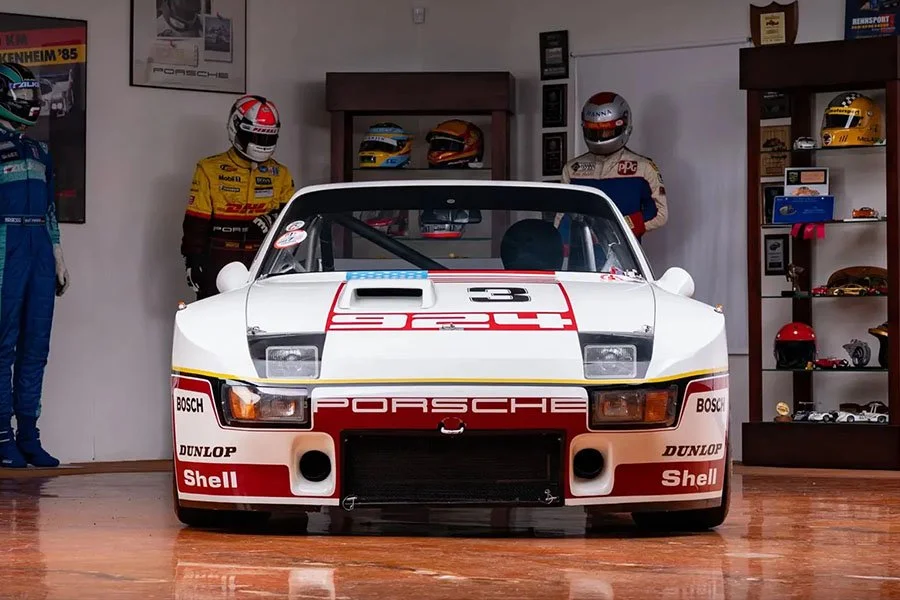Guide: Porsche 911 2.0 R - a Historical & Technical Appraisal
/BACKGROUND
Although Porsche’s competition programme was mainly focused on Sports Protoypes during the mid 1960s, a modest campaign with the newly launched 911 was embarked upon beginning in 1965.
That year, Porsche headed to the Monte Carlo Rally with a lightly prepared O-series 911. It ultimately finished a respectable fifth overall and second in class behind a factory 904.
The choice of a high profile one-off rally outing for this debut showing owed much to the fact that a prolonged factory assault on a major series was out of the question. An appearance on the Monte seemed like a good way to boost the 911’s performance and reliability credentials at a time when the 904 GTS was the dominant force in the under two-litre class of the World Sportscar Championship.
A more serious rally programme was embarked upon in 1966 when Porsche’s Vic Elford became that year’s European champion driving another lightly modified 911.
Towards the end of the 1966 season, Porsche’s new head of R&D, Ferdinand Piech, came up with a plan to push the 911 to the limit of its performance. Piech (who was Ferry Porsche’s nephew) wanted a 911 that was as light and powerful as possible.
Since the beginning of 1966 (when a new regularity framework had been introduced), the relevant motor sport regulations comprised Group 6 (a Prototype class with no minimum production requirement), Group 4 (a Sports class with a build requirement of 50 cars) and Group 3 (a Grand Touring category with a 500 car entry requirement).
For 1966, the existing 911 S had been homologated in the Group 3 class and the 906 Carrera 6 had been created to contest the two-litre Group 4 category.
For 1967, Porsche would continue to compete with both models in addition to developing new 907 and 910 Group 6 Prototypes. All in all it was a busy time for the competition department.
Piech would initially try to get his new super 911, dubbed the 911 R, homologated in Group 3 as a straightforward evolution of the 911 S.
Between late 1966 and early 1967, four prototypes were built: chassis 305876S (R1), 306681S (R2), 307671S (R3) and 307670S (R4).
All four cars were stripped to the bone, fitted with a host of lightweight parts and the trick two-litre engine from the 906.
Unfortunately, Porsche’s attempt to homologate the 911 R as a Group 3 machine was unceremoniously thrown out; having recently been conned by Ferrari, the governing body were taking a hard line on such matters and were in no mood to be duped again.
It was thought the 911 R could be retailed at about twice the price of a standard 911 S, but Porsche’s sales department informed Piech there was absolutely no chance of selling the 500 cars required for Group 3. Neither was there any point in building the 50 cars required by Group 4 which was the domain of super specialised machinery such as the 906.
Nevertheless, having invested some time and effort in creating the 911 R, Porsche decided to build a limited run of 20 additional cars (chassis 001R to 020R). Five of these would be reserved for factory use and the remaining 15 would be sold to customers.
Although the 911 R would have to run in the Group 6 Prototype class, it would prove a highly effective machine for certain types of events such as rallies, road races and hillclimbs.
To promote the new car, Porsche debuted one of the original prototypes (R2) at the Mugello GP World Sportscar Championship road race in July 1967. Further outings then followed during the remainder of the year.
CHASSIS
Each 911 R was based on a standard unitary steel bodyshell that was lightened through the absence of underseal and sound insulation. Certain parts were also drilled out to save a few extra kilograms. For use on rough surfaces, additional underbody protection could be added if required.
The existing suspension layout was unchanged: MacPherson struts up front and semi-trailing arms with a transverse torsion bar at the rear. For circuit use, the 911 R was routinely uprated with stiffer Koni dampers. Thicker anti-roll bars were always fitted.
As per the 911 S, ventilated disc brakes were used all round along with competition Ferodo pads.
The standard 4.5-inch wide Fuchs alloys fitted to the 911 S were normally switched in favour of 6-inch rims at the front and 7-inch rims at the back.
A long-range 100-litre fuel tank was fitted in the trunk. It came with a competition quick filler cap that poked through the front lid.
ENGINE / TRANSMISSION
The 911 R’s Type 901/22 engine was adapted from the 901/20 unit found in the Group 4 906 sports racing car. The primary difference was a reinforced forged aluminium instead of magnesium crankshaft.
Both power units used a magnesium alloy block and head with titanium connecting rods, dual ignition, a 10.3:1 compression ratio and two banks of Weber 46 IDA3C carburettors.
Similarly, displacement was 1991cc thanks to a bore and stroke of 80mm and 66mm respectively.
Peak output was the same for both cars: 210bhp at 8000rpm and 145lb-ft at 6000rpm.
The 911 R came with an aluminium oil tank mounted ahead of the right-hand side rear wheel and an un-silenced twin-pipe free-flow exhaust.
Some cars were subsequently fitted with the 230bhp fuel-injected Type 901/21 engine from the Porsche 910.
Transmission was through a five-speed manual gearbox, single-plate clutch and limited-slip differential.
BODYWORK
To save weight, the 911 R was equipped with a series of lightened body parts.
The bumpers, doors, front lid and engine cover were manufactured from fibreglass by the Bauer coachworks in Stuttgart. One exception was chassis R3 which had aluminium opening panels.
The thin steel fenders were subtly flared to accommodate wider wheels.
The glass windscreen was thinner than normal (just 4mm) and Plexiglas was used for the other windows (2mm). The rear quarter windows were each given a bank of seven ventilation slots.
Instead of the normal supplementary light clusters, Porsche fitted smaller lenses sourced from Volkswagen and NSU. The rear lights were housed in body coloured shrouds. The fronts were attached direct to the body alongside simple cut-outs instead of the normal horn grilles.
Other special lightweight equipment included the wipers, door handles, headlight trim rings, engine grille and door hinges. Even the wheel caps were left off to save a few extra grams.
Mounted on the right-hand rear fender behind the door handle was the filler cap for the oil tank.
An adhesive Porsche script was normally applied along each sill and rubber or stainless steel front lid tie-downs were routinely fitted for competition use.
INTERIOR
Weight-saving was also the theme inside.
Porsche deleted a long list of equipment to include all of the sound insulation, the carpet and floor mats, various switches, the passenger sun visor, the cigar lighter, ashtray, horn and the glovebox cover.
Much plastic was used in the construction of the dash. The clock was blanked off and the combined oil level / fuel gauge switched to a fresh air vent. Instrumentation comprised a new 10,000rpm rev counter flanked to the right by a 250kmh speedometer and to the left by a combined oil pressure / oil temperature read out.
A small diameter three-spoke Momo Prototipo steering wheel was standard along with a short-throw gear lever.
Instead of conventional winders, the simplified door panels used leather straps to raise and lower the Plexiglas side windows. The vented rear quarter windows were fixed in position.
The heavy production car seats were switched to black leatherette Scheel buckets with ribbed fabric centres and four-point harnesses.
WEIGHT / PERFORMANCE
At 810kg, the 911 R weighed an incredible 230kg less than a contemporary 911 S.
Depending on the gear ratios, a top speed of 154mph was possible along with a 0-62mph time of 5.7 seconds.
PRODUCTION
The first prototype (chassis 305876 S, also known as R1) was completed in October 1966. Three more examples then followed which were variously tested at Weissach, Hockenheim and the Nurburgring.
1967 MUGELLO GP
The 911 R made its competition debut at the Mugello GP on July 23rd 1967.
The 530km contest was round nine of the 1967 World Sportscar Championship and took place on a 66km Tuscan road course that weaved through the Apennine mountains.
Porsche selected chassis R2 for the event and took R1 along to serve as a practice hack. The 911 R was allocated to Vic Elford and Gijs van Lennep. It formed part of a six-car works entry that also comprised a trio of Group 6 910s and a pair of Group 4 906s.
The 910s were entered for Jo Siffert / Hans Herrmann (two-litre Flat 6 engine), Udo Schutz / Gerhard Mitter (2.2-litre Flat 8) and Jochen Neerpasch / Rolf Stommelen (2.2-litre Flat 8). The 906s were entered for Gerhard Koch / Dieter Glemser and Leo Cella / Giampiero Biscaldi.
Like Autodelta, the Porsche crews arrived several days before the event to practice. In addition to the Autodelta squad, chief opposition was expected from Scuderia Ferrari and Ford France.
Unfortunately, on the first official day of practice, Ferrari’s Gunther Klass lost his life in a nasty accident. While heading down from the Giogo Pass to Firenzuola, Klass went off the road and his Dino Spyder hit a tree hard on the driver’s side. The car burst into flames and Klass was trapped behind the wheel.
Klass (who had previously raced for Porsche) was eventually freed and airlifted to hospital, but pronounced dead on arrival.
The eight lap race began at 1pm on Sunday with cars sent off in ten second intervals.
At the end of lap one, the Flat 8-engined 910s of Schutz and Neerpasch led Schlesser’s Mk2 GT40. Lucien Bianchi’s Alfa Romeo 33/2 was fourth and Elford fifth in the 911 R. Siffert (who had been fastest in practice) went out early on when his car stopped up in the mountains.
At the end of lap three, Elford handed over to van Lennep who continued to circulate at around the same pace.
Elford was back in R2 for the last two laps, at which time the 911 R was still in fifth position. However, on the final lap, the Koch / Glemser 906 and the Schlesser / Ligier GT40 stopped out on track. Elford crossed the line third overall to win the two-litre Prototype class.
The 2.2-litre Flat 8-engined 910s of Schutz / Mitter and Neerpasch / Stommelen finished first and second to give Porsche a clean sweep of the podium.
1967 MARATHON DE LA ROUTE, NURBURGRING
Porsche’s next outing with a 911 R was arguably the most daunting prospect on the calendar: the 84 hour Marathon de la Route at the Nurburgring.
Created in 1965 to replace the Liege-Rome-Liege Rally, the Marathon de la Route combined the Nordschleife and Sudschleife circuits to give a 28.2km lap.
The 1967 running was Porsche’s first crack at the Marathon and took place between August 22nd and 26th. The German firm sent a three car team that comprised a 911 R (chassis R3) and a brace of 911 S. For promotional reasons, R3 and one of the sister cars was fitted with Porsche’s new Sportomatic transmission.
R3 also ran the event with a less highly tuned 175bhp 911 S Rally Kit engine. It was entered for Vic Elford, Hans Herrmann and Jochen Neerpasch.
The sister cars were allocated to Gerhard Koch / Hans Schuller / Terry Hunter (911 S Sportomatic) and Giorgio Pianta / Jean-Pierre Gaban / Noel Van Assche (911 S).
The race got underway at midnight on Tuesday 22nd when the 43 starters were led away by Neerpasch in the 911 R and the Ford Belgium-entered Mustang driven by Taf Gosselin. However, the Neerpasch-Gosselin battle lasted less than an hour when the Mustang came in with serious rear suspension problems.
Unfortunately, during the fourth hour, the race was marred by a fatal accident when the 911 of Georges Berger left the road at high speed. Berger died of his injuries a short time later.
By the sixth hour, the 911 R had a full lap lead over Pianta / Gaban / Van Assche. In the eighth hour the manual 911 S span off and then dropped down the order while repairs were carried out to the bodywork and fuel tank.
Rain began to fall as the two leading Sportomatic Porsches headed into the second night.
By dawn on Thursday they had a ten lap lead over the chasing Minis while the manual sister car was making up for lost time after a second off-track excursion.
Fog rolled in on Thursday evening and by Friday morning the field was down to just 17 runners.
At 9am on Friday there was drama in the Porsche pit when the 911 R came in with a cracked front disc. A replacement took 15 minutes to fit which dropped the car to third.
The Koch / Schuller / Hunter Sportomatic 911 S thus took over at the head of the field.
At 2:10pm, the Pianta / Gaban / Van Assche 911 S crashed again and was finally retired. Shortly afterwards, the leaders were also in trouble when Koch brought the Sportomatic 911 S in with a rough sounding engine. The Porsche mechanics tried to fit a fresh engine, but did not manage to do so in the allotted time and the car was retired shortly before 5pm.
This left the 911 R in second behind the Andrew Hedges / Tony Fall / Julian Vernaeve Mini Cooper S.
14 cars headed into the final night, during which the 911 R re-took the lead. However, a cracked oil pipe meant it was having to make frequent stops.
By dawn, the pace had dropped as most crews just wanted to make the finish.
The 911 R of Elford / Herrmann / Neerpasch ultimately finished 34 laps ahead the Hedges / Fall / Vernaeve Mini Cooper S. They had completed the 84 hour event at an average speed of 117.8kmh. In third spot was the Volvo 122 S of Hans Wangstre / Evert Christofferson which finished on the same lap as the Mini.
After its victorious outing, R3 was converted back to a manual gearbox and re-fitted with its R-spec. engine.
1967 COUPES DES ALPES
Two weeks after their win at the Nurburgring, Porsche sent a three car team that included a 911 R to contest the Coupes des Alpes.
The five-day all-tarmac event took place between September 4th and 9th. It was round 14 of the European Rally Championship and Porsche were expected to face a stiff challenge from the Alpine Renault and BMC teams.
Chassis R2 (as used at the Mugello GP) was entered for Vic Elford and his navigator, David Stone. Two other factory 911s were also in attendance: one for Jean-Pierre Hanrioud / Michel Gauvain and the other for Sobieslaw Zasada / Ryszard Nowicki.
The rally departed Marseille late on Monday night. It headed up to the Alpe d’Huez and then looped back down to Menton.
Elford led the early stages, but then dropped behind the Alpines of Gerard Larrousse and Jean Vinatier when he suffered a puncture and lost three minutes on the section into Entrevaux.
Elford and Stone were then first on the scene when, 1km from the top of Col d’Allos, the Renault Gordini of Jean-Pierre Rouget and Claude Roitburg went off the road and plunged 100ft down the mountainside. Neither was wearing seatbelts or helmets and they were thrown from the car when the doors sprang open.
Jean-Pierre Roitburg was flown to hospital in Nice, but died of his injuries a short time later. Claude Rouget recovered at a hospital in Gap.
On the only part of the route to run into Italy, Elford suffered his second puncture and lost another three minutes.
After Mont Ventoux, team-mate Zasada retired his 911 S with a broken gearbox.
At the end of the first leg, just 38 of the 80 starters were still in the rally. The Alpines of Larrousse and Vinatier were first and second. Despite his troubles, Elford was fifth and team-mate Hanrioud tenth.
The second leg of the rally was quite short and ran through the daylight hours of Wednesday. Unfortunately, Elford’s 911 R was the first to retire; the engine dropped a cam follower about 6km up the Col de Pennes which broke the camshaft on one cylinder bank.
Hanrioud also later retired along with the Alpines.
Victory fell to the Mini Cooper S of Paddy Hopkirk and Ronald Crellin. They finished ten minutes clear of the chasing Alfa Romeo Giulia GTA driven by Berard Consten and his navigator, Jean-Claude Peray.
1967 SCHWABISCHE ALB-NEUFFEN HILLCLIMB
On September 24th, Gerhard Mitter took the wheel of a 911 R for the Schwabische Alb-Nueffen Hillclimb in Baden-Wurttemberg, southern Germany.
Mitter, the 1966 and 1967 European Mountain champion for Porsche, used chassis R1 (the practice car at Mugello) instead of his usual Flat 8-engined 910 Bergspyder. He finished third overall and won the two-litre Prototype class.
1967 MONZA SPEED RECORDS
In late October Porsche, BP Switzerland and Firestone joined forces in an attempt to set a series of new World Speed Records at Monza.
The idea came from recently appointed Porsche racing manager, Rico Steinemann. The records in question (15,000km, 10,000 miles, 20,000km, 72 hours and 96 hours) had belonged to Porsche back in the 1950s, but since then Ford and Toyota had set new benchmarks.
Even though its track surface was not ideal, Monza was chosen for the record attempt as the other European option, Montlhery, was not considered fast enough.
BP Switzerland bankrolled the attempt as they wanted to demonstrate the performance of a new engine oil. The team would comprise four Swiss drivers (Steinemann and Dieter Spoerry plus Jo Siffert and Charles Vogele) who would use Vogele’s Porsche 906 for the attempt. Each driver would do a one-and-a-half hour stint behind the wheel followed by four-and-a-half hours rest.
The rules stated that all spare parts used in the record attempt had to be carried in the car. All that was allowed in the pit were spare wheels, jacks, spark plugs, fuel and oil.
The record attempt began at midday on Monday October 30th. However, after two shock absorber failures and the front left spring strut pivot point on the tube frame being torn out (all caused by the poor condition of the Monza banking), it was soon abandoned.
As the regulations permitted the resumption of the record attempt within 48 hours, Porsche quickly arranged to send three 911 Rs to Monza.
Because there was not enough time to organise the customs formalities for a quota of spares for the record attempt, chassis 002R (the first production 911 R to have been completed) was immediately sent to Monza under its own power. It would then be stripped of any relevant parts along with those from a third car that travelled to Italy, chassis 003R.
In the meantime, chassis 001R (which would serve as the actual record car) was prepared with two fifth gears in one ‘box (instead of a conventional fourth and fifth); it was thought a single fifth gear would be unable to bear the full load during the record attempt. The engine in 001R had already done 100 hours flat out on test bench.
Meanwhile, 002R was heading rapidly to Monza. However, at the German-Swiss border, the Swiss authorities refused to let the car into the country on noise grounds. As a result, the driver was forced to take a furious all-night detour around Switzerland via Lyon, Grenoble and Turin.
Having been informed of the situation, Peter Falk and engine expert Paul Hensler set off in 001R and took the more direct route through Austria and over the Brenner Pass. They arrived on the morning of Tuesday 31st.
The record attempt was resumed at 8pm later that day in cold and rainy conditions. An early problem with iced up carburettors was resolved by the BP crew with an injection additive.
Wednesday was dry and the second night passed without incident. Pit stops took little more than a minute.
Thursday was another wet one and after the crew ran out of rain tyres, the Firestone experts hand-cut rain grooves into the remaining dry tyres.
At 8pm on Saturday 4th November, despite miserable weather, often appalling visibility and a couple of stops for damper changes, the crew had completed four days of running. Porsche claimed the five World Speed Records targeted and also set 14 international class records at an average speed of 209kmh.
A few days after the gruelling event, BP Switzerland displayed 001R at the inaugural Zurich Racing Car Show.
1967 TOUR DE CORSE
The final outing Porsche made with a 911 R in 1967 was the Tour de Corse which took place between November 4th and 6th. The all-tarmac Corsican event was regarded as the most difficult and demanding road rally of the season despite only covering around 650km (130km of which were special stages).
R2 (the car used for the Mugello GP and Coupes des Alpes) was allocated to Vic Elford and his navigator, David Stone. A 911 S Rally Kit engine was fitted for reasons of reliability.
Although R2 was the only factory Porsche entry in attendance, it was joined by chassis 006R which belonged to French privateer, Fernand Schligler. 006R was the first customer 911 R to appear in competition. Schligler was accompanied by navigator, Gerard Couzian.
The Porsches were most notably up against a team of factory Lancia Fulvia Prototypes and the works Alpine Renault crew.
The rally began at 6pm on Saturday evening and the competitors departed Ajaccio in heavy rain.
At the end of the first leg, Sandro Munari’s tricked out Lancia led Elford by three seconds. Fernard Schligler retired 006R early on with mechanical problems.
The rain continued unabated during the second leg, during which Munari demonstrated his superiority and extended Lancia’s lead. Elford just about clung onto his second place despite pressure from the Lancia sister car of Pauli Toivonen.
Elford then found himself with a little breathing space when Toivonen had an off-road excursion and bent his steering as daylight approached. The Finn dropped two minutes, but the Lancia mechanics managed to repair the Fulvia before third leg kicked off.
Elford set fastest time on third leg and looked comfortable in second position.
However, on the fourth and final leg, he put on a charge in an attempt to catch Munari and left the road on the slippery descent to Evisa. Elford dropped nearly two-and-a-half minutes and was then docked a further 60 seconds with a road penalty at the St. Roch control.
This relegated the 911 R to third, 63 seconds behind Toivonen with just a short distance to go.
Elford managed to close the gap when the Finn had to tackle the final stage without his auxiliary lights, but Toivonen ultimately finished three seconds ahead to claim the runner’s up spot and give Lancia a one-two finish.
CLOSE SEASON & CUSTOMER CARS FOR 1968
Having demonstrated the effectiveness of the 911 R in a wide range of events, Porsche mostly left the racing, rallying and hillclimbing of 911 Rs to their customers in 1968.
The first 911 R production car (002R) was presented at Porsche’s Hockenhim Press Day in late December 1967.
Among the most successful privateers that season were Juan Fernandez (007R) and Manual Nogueira Pinto (010R). The 911 R delivered to French distributor Sonauto (018R) also scored some impressive results in the hands of Jean-Claude Andruet (most notably victories on the Rallye du Tour de l'Aisne and Rallye de Picardie).
1968 MUGELLO GP
The sole appearance for a factory owned 911 R in 1968 came at the Mugello GP on July 28th.
For this event, chassis R1 (the practice mule from Mugello the previous year and the car driven by Gerhard Mitter at the Schwabische Alb-Nueffen Hillclimb) was loaned to the Swiss-based Hart Ski Racing Team.
Hart Ski was a personal sponsor of Jo Siffert and also backed the 910 driven by Rico Steinemann / Dieter Spoerry in 1968.
As a result of the previous year’s fatal crash that claimed the life of Scuderia Ferrari driver, Gunther Klass, the Mugello GP had lost its World Championship status for 1968. Nevertheless, it still attracted a strong list of privateers plus works entries from Autodelta and Lancia.
The Hart Ski Racing Team entered their Porsche 910 for Jo Siffert / Rico Steinemann and the 911 R for Dieter Spoerry / Ben Pon.
Other quasi-works Porsches in attendance were a Bill Bradley 910 for Vic Elford / Gijs van Lennep and a Gerhard Koch-entered 910 for himself and Rudi Lins.
All cars competing at Mugello in 1968 were limited to a maximum engine size of two-litres. The event once again comprised eight laps of a 66km Tuscan road course.
Practice took place on the Saturday between noon and 6pm. Unfortunately, Elford and Koch both crashed their 910s too badly to make the start-line.
The race got underway at 1pm on Sunday.
With one lap complete, Siffert’s Hart Ski 910 led the Tipo 33/2 Alfas of Nanni Galli and Mario Casoni.
Siffert continued to pull away, but when Steinemann was behind the wheel on lap six, the 910 lost time when it hit a rock and picked up a puncture. Siffert got back in the car for the two lap run to the flag, however, he faced a six minute gap to Galli in the lead Alfa.
By this stage, only five cars were still on the lead lap. The 911 R had been promoted to third after the Alfas of Pilette / Zeccoli, Casoni / Dini and Biscaldi / Facetti all retired.
Siffert ultimately reduced the gap to Galli by a little over two minutes while, after a fast and consistent run throughout, Spoerry / Pon claimed the final podium spot in the 911 R. They eventually crossed the line 22 minutes behind second-placed Siffert / Steinemann and were just 71 seconds ahead of the fourth-placed Caltex Racing Team Porsche 906 driven by Erich Bitter and Pauli Toivonen.
1969 TARGA FLORIO
After a factory-owned 911 R had made just one competitive appearance during 1968, their was something of a resurgence for 1969 when Porsche entered a works machine for the Targa Florio, Tour de France and Tour de Corse.
The Targa Florio was round five of the 1969 World Sportscar Championship and took place on May 4th.
Porsche were looking to take their third consecutive win of the 1969 world championship and their fourth consecutive win in Sicily. To this end they sent a formidable entry and one of the largest ever seen.
It comprised a previously unseen 911 R (chassis 005R) and no less than six works 908/02s. The 908s were entered for Vic Elford / Umberto Maglioli, Richard Attwood / Brian Redman, Gerhard Mitter / Udo Schutz, Rolf Stommelen / Hans Herrmann, Rudi Lins / Gerard Larrousse and Willy Kauhsen / Karl von Vendt.
005R was allocated to Dieter Spoerry and Pauli Toivonen. It was equipped with a 230bhp engine with guillotine injection.
The race kicked off 25 minutes late at 8:25am. Unfortunately, 005 didn’t make it beyond the second lap; an engine fire caused it to retire up in the mountains and Pauli Toivonen never got a chance to drive.
Nevertheless, the 1969 Targa Florio was a major success for Porsche; the 908/02 of Mitter Schutz won the event and was followed by home by the sister cars of Elford / Maglioli, Stommelen / Herrmann and Kauhsen / von Wendt as Porsche swept the top four positions.
1969 TOUR DE FRANCE
Chassis 005R made its second appearance of the year when Porsche selected it as their sole factory representative for the Tour de France. Porsche fitted the car with a tuned 911 S motor instead of the R engine as they figured it would be more reliable and not much slower. 005R was entered for Gerard Larrousse and his navigator, Maurice Gelin.
The 1969 Tour de France was the first running of the event since 1964 after a lack of sponsorship had seen it drop off the calendar.
For 1969, the contest was opened up to Prototype class machinery. Opposition to the works 911 R was most likely to come from a brace of Ford GT40s (entered by Ford France and Willie Green), a Ferrari 250 LM (entered by Scuderia Filipinetti), a pair of 910 Porsches (from Henri Balas and Christian Poirot), the Greder Racing Team Chevrolet Corvette and Jean-Pierre Hanrioud’s Ferrari 275 GTB/C. Other Porsches in the event included a couple of Sonauto 911s plus 904s, 906s and a privateer 911 R entered by Rene Mazzia (chassis R1).
The eight day contest took place from September 18th to the 26th. Unusually the entire event was held in almost perfect weather.
The first leg saw the crews travel from Nice through the night to Nancy. It comprised over 1000 miles of regularity sections, six hillclimbs and one epreuve chronometree (a hillclimb in all but name as did not go uphill all the way).
At the 10km L’Orme Hillclimb, Larrousse posted fifth quickest time behind a brace of 910s, a 906 and another 911. He had a steady run up the course whereas the winner (Henri Balas) threw caution to the wind,
Perhaps realising he could not let his opponents get too far ahead, Larrousse then put in a storming performance up the 21km Mont Ventoux course to win by 18.7 seconds. Guy Chasseuil was second in his Sonauto 911 and Claude Larrieu third in his 906; the misty conditions had been much better suited to GT cars as opposed to Sports Prototypes.
By this time, the highly fancied Porsche 910 of Christian Poirot and the Ford France GT40 of Michel Martin had already dropped out of the event.
At the 6.3km Col Bayard Hillclimb, the 910 of Balas beat Larrousse in the 911 R by 7 seconds. Henri Greder was third in his brawny Chevrolet Corvette.
The 17.2km Chamrousse Hillcllimb subsequently saw lots of accidents, but the result was the same: Balas from Larrousse by five seconds and Greder back in third.
Then came the 6.3km Mont Revard Hillclimb where Larrousse won by five seconds from Guy Chasseuil’s Sonauto 911. On this occasion, Jean-Claude Andruet’s works Alpine A110 was third.
By the time the cars reached the Ballon d’Alsace Hillclimb it was daylight again. Larrousse went fastest up the 8.8km course in the 911 R. Balas was six seconds back in his 910 and Chasseuil a further four seconds down the road in the Sonauto 911.
On the 20km Rainkopf epreuve, Larrousse was finally able to pull clear of Balas having only had a slight advantage beforehand. In thick swirling fog the prototypes were at a major disadvantage and Balas didn’t even make it into the top ten. Larrousse finished 15 seconds ahead of Chasseuil and Andruet was third for the second event in succession.
To complete a good session for Larrousse, the seventh-placed Willie Green GT40 (perhaps the only car that could realistically overhaul the 911 R on the circuits) stripped its first gear and retired.
After the necessary calculations (hillclimb leads were multiplied by a factor of three), Larrousse closed out the first leg with a four minute advantage over Chasseuil (911) and a nine-and-a-half minute gap to Balas (910).
Following an evening halt in Nancy, the crews departed at midnight to begin leg two.
The first stop was the Nurburgring circuit in Germany where the organisers had laid on a six lap 137km race which began at 6am. As expected, Greder (who had been ninth overall, some 15 minutes behind Larrousse) won the Nordschleife event. He finished four minutes clear of the 911 R which in turn crossed the line 40 seconds ahead of Chasseuil’s Sonauto 911.
From Germany, the convoy headed to Spa in Belgium where Jean-Pierre Rouget won the 282km 20 lap race in his Filipinetti Ferrari 250 LM. Greder claimed second in his Corvette, just under a minute behind. Larrousse rounded out the podium 66 seconds behind Greder.
By the time the drivers reached the night halt at Reims, the Henri Balas Porsche 910 had finally retired with a broken exhaust after it had experienced significant delays as a result of several minor difficulties.
Leg three began with a 274km 33 lap race at Reims which Rouget’s 250 LM won by four-and-a-half minutes from Greder’s Corvette. Jean-Pierre Hanrioud was third in his Ferrari 275 GTB/C and Larrousse was fourth in the 911 R (a minute behind Greder who was shaping up to be his closest challenger).
The Reims event was followed by a long trek west to Rouen for a 24 lap 130km race where Rouget cooked the engine in his Filipinetti 250 LM. This left Greder’s Corvette to take the win. Hanrioud’s 275 GTB/C was 61 seconds back and Larrousse claimed third (67 seconds behind Greder).
Following Rouget’s retirement at Rouen, the Ferrari challenge then disappeared completely when the clutch in Hanrioud’s 275 GTB/C broke on the night section to Brittany. Barring any problems, this left Greder as the sole competitor who could realistically challenge Larrousse in the 911 R.
The fourth leg kicked off with a 270km 66 lap race at the Le Mans Bugatti circuit which Greder won from Larrousse by 21 seconds. Jean Egreteaud was third in his privateer 911.
Greder then recorded fastest time at the Cap Frechel chronometree while Larrousse came home in fourth spot. He gave up 26 seconds to the Corvette and also finished behind the 911s of Chasseuil and Egreteaud.
Unfortunately for Greder, the next morning found him with a broken exhaust and by the time he arrived at Magny Cours, his engine had begun to misfire.
Larrousse won the short 50km 13 lap race at Magny Cours by 22 seconds from the 911s of Egreteaud and Chasseuil. He reclaimed 66 seconds from Greder who finished a distant sixth.
Then followed a 30 lap 241km marathon at Clermont-Ferrand where, despite an opening lap spin, Greder’s now smooth-running Corvette went on to win by 40 seconds from Larrousse. Guy Chasseuil was another 27 seconds back in third.
This result meant Greder finally moved into second place in the overall standings ahead of Chasseuil. However, Larrousse now had such a lead that there was no realistic chance of him being caught unless the 911 R began to experience mechanical problems.
After driving through the night, the crews undertook the 21km Minier Hillclimb where Larrousse extended his lead after winning the event by nine seconds from Jean-Claude Andruet’s Alpine A110. Chasseuil’s 911 was third and Greder’s Corvette fourth.
Greder then consolidated his second position in the standings during the 145km 40 lap race at Albi where he won by a clear three minutes from Larrousse. Chasseuil was two seconds back in his standard Sonauto 911.
At the overnight stop in Albi, Larrousse was sitting on a ten minute gap to Greder with just three events to go during the final day.
Guy Chasseuil won the 12km Aspin Hillclimb by 12 seconds from Larrousse with Greder a further 14 seconds back in third.
Greder then emerged victorious at the 12.3km Tourmalet Hillclimb. He beat Chasseuil by 2.4 seconds with Larrousse another 14 seconds down the road.
Fittingly, Larrouse won the 53km 30 lap finale at Nogaro. The 911s of Chasseuil and Egreteaud rounded out the podium with Greder fourth.
Gerard Larrousse / Maurice Gelin therefore took a well-deserved victory on the 1969 Tour de France to claim the 911 R’s most significant win. Their overall time was 14 hours, 25 minutes and 51 seconds.
Henri Greder / Andre Vigneron were second in 14 hours 36 minutes and 35 seconds. Guy Chasseuil / Christian Baron missed out on the runner’s up spot by just 72 seconds.
1969 TOUR DE CORSE
Six weeks after their epic win at the Tour de France, Gerard Larrousse, Maurice Gelin and chassis 005R attended what would be the 911 R’s final works outing: the 1969 Tour de Corse on November 8th and 9th.
Held over ten tarmac stages totalling 220km, the Corsican event attracted a stellar entry that comprised factory teams from Alpine Renault, Lancia and Ford.
Some reports stated 005R was fitted with the 230bhp guillotine injection engine seen at the Targa Florio. Others stated a tuned 911 S motor was installed.
The rally got underway in drizzly conditions and the Alpine A110s of Andruet and Vinatier immediately moved to the head of the field as the Lancias encountered trouble. However, Vinatier went off during the third stage while Andruet began to encounter carburettor problems. He then picked up a puncture and hit a wall on stage five which left Larrousse at the head of the field with a clear run to the finish.
Larrousse proceed to set fastest times on the next four stages and cruised round on the tenth to win by 76 seconds from the works A110 of Pierre Orsini / Jean-Baptiste Canonici.
Victory on the 1969 Tour de Corse brought the 911 R’s frontline factory career to a close.
Text copyright: Supercar Nostalgia
Photo copyright: Porsche - https://www.porsche.com

